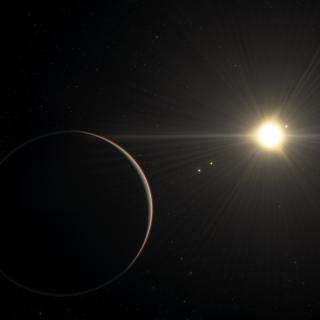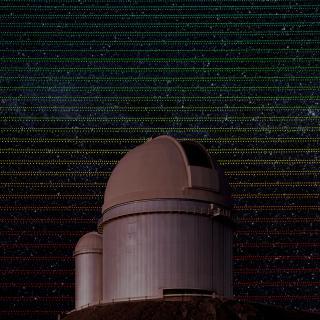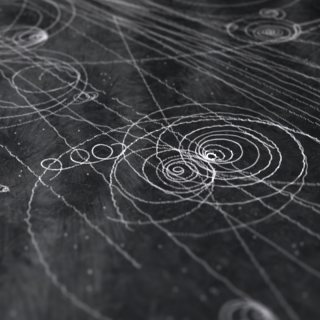Subvenciones relacionadas:
General
La búsqueda de vida en el Universo se ha visto impulsada por los recientes descubrimientos de planetas alrededor de otras estrellas (los llamados exoplanetas), convirtiéndose en uno de los campos más activos dentro de la Astrofísica moderna. En los últimos años los descubrimientos cada vez más numerosos de nuevos exoplanetas y los últimos avances en el estudio de sus atmósferas no sólo están dándonos valiosa nueva información sobre sus propiedades físicas, sino que nos están permitiendo además poner las propiedades de los planetas de nuestro Sistema Solar dentro un contexto más global. El campo esta acercándose al importante descubrimiento de los primeros planetas potencialmente habitables, impulsando estudios más detallados de estos planetas. Con el lanzamiento de las nuevas misiones como JWST, CHEOPS, TESS, ARIEL o PLATO, al campo de exoplanetas se le plantea un futuro muy excitante.
Es por esta razon que este campo se ayuda de y, a su vez motiva, el desarrollo de instrumentación cada vez más sensible y estable tanto para telescopios de tierra como para las misiones espaciales. Dos frentes para los que nuestro grupo esta especialmente preparado. Por un lado, durante los ultimos años hemos desarrollado tecnicas de observacion y reduccion de transitos de exoplanetas para los telescopios del ORM, siendo el nuestro uno de los grupos mas productivos en la explotacion de GTC. Por otro lado, todas las misiones espaciales ESA (presentes y futuras) relacionadas con exoplanetas cuentan con uno o varios de los componentes del proyecto como CoIs.
En el marco de este proyecto, pretendemos que los investigadores del IAC mantengan una situación aventajada con la explotación de OSIRIS y EMIR, instrumentos de primera luz de GTC, y participen en la construcción, comisionado y operación de nuevos instrumentos, como el espectrografo óptico de alta resolución HORUS en el GTC. La explotacion de la fotometria y espectroscopia de transitos con LIRIS en el WHT es tambien uno de nuestros principales intereses, especialmente en preparacion de la instalacion en 2015 del instrumento EMIR en el GTC.
En resumen, el proyecto "Exoplanetas y Astrobiologia" se centrará entorno a estas cuatro lineas principales de actuacion:
1) Caracterización de las propiedades fisicas y atmosfericas de exoplanetas (GTC, WHT, HARPSN, CARMENES, ESPRESSO, ARIEL etc.)
2) Búsquedas y confirmacion de exoplanetas por transitos (CoRoT, Kepler, K2, CHEOPS, XO, LCOGT, WFC, PLATO, etc.)
3) Busquedas/ confirmacion de exoplanetas por velocidad radial (HARPSN, HORUS, LCOGT, SONG, CARMENES)
4) Astrobiología
Miembros
Resultados
- Deteccion de He en la atmosfera de un exoplaneta por primera vez, publicado en Science.
- Deteccion de un planeta entorno a la estrella de Barnard, publicado en Nature
- Deteccion de los primeros planetas del la mision TESS, con varios articulos de impacto
- Descubrimiento de rasgos de Na y Halpha en el espectro de KELT-20b con el TNG
- Publicación del Handbook of Exoplanets, la obra de referencia más extenso en el campo de los exoplanetas. Este Manual fue editado por miembros de nuestro grupo e incluye contribuciones de unos 300 expertos en todo el mundo, incluidos 12 miembros de IAC.
Actividad científica
Publicaciones relacionadas
-
Sub-stellar companions of intermediate-mass stars with CoRoT: CoRoT-34b, CoRoT-35b, and CoRoT-36b
Theories of planet formation give contradicting results of how frequent close-in giant planets of intermediate mass stars (IMSs; $1.3\le M_{\star }\le 3.2\, \mathrm{M}_{\odot }$) are. Some theories predict a high rate of IMSs with close-in gas giants, while others predict a very low rate. Thus, determining the frequency of close-in giant planets of
Sebastian, D. et al.Fecha de publicación:
102022 -
The GAPS Programme at TNG. XXXVII. A precise density measurement of the young ultra-short period planet TOI-1807 b
Context. Great strides have been made in recent years in the understanding of the mechanisms involved in the formation and evolution of planetary systems. Despite this, many observational findings have not yet been corroborated by astrophysical explanations. A fine contribution to the study of planetary formation processes comes from the study of
Nardiello, D. et al.Fecha de publicación:
82022 -
A stellar occultation by the transneptunian object (50000) Quaoar observed by CHEOPS
Context. Stellar occultation is a powerful technique that allows the determination of some physical parameters of the occulting object. The result depends on the photometric accuracy, the temporal resolution, and the number of chords obtained. Space telescopes can achieve high photometric accuracy as they are not affected by atmospheric
Morgado, B. E. et al.Fecha de publicación:
82022 -
The HD 260655 system: Two rocky worlds transiting a bright M dwarf at 10 pc
We report the discovery of a multiplanetary system transiting the M0 V dwarf HD 260655 (GJ 239, TOI-4599). The system consists of at least two transiting planets, namely HD 260655 b, with a period of 2.77 d, a radius of R b = 1.240 ± 0.023 R ⊕, a mass of M b = 2.14 ± 0.34 M ⊕, and a bulk density of ρ b = 6.2 ± 1.0 g cm −3, and HD 260655 c, with a
Luque, R. et al.Fecha de publicación:
82022 -
TESS Hunt for Young and Maturing Exoplanets (THYME). VII. Membership, Rotation, and Lithium in the Young Cluster Group-X and a New Young Exoplanet
The public, all-sky surveys Gaia and TESS provide the ability to identify new young associations and determine their ages. These associations enable study of planetary evolution by providing new opportunities to discover young exoplanets. A young association was recently identified by Tang et al. and Fürnkranz et al. using astrometry from Gaia
Newton, Elisabeth R. et al.Fecha de publicación:
92022 -
The GAPS Programme at TNG XXXIX. Multiple Molecular Species in the Atmosphere of the Warm Giant Planet WASP-80 b Unveiled at High Resolution with GIANO-B
Detections of molecules in the atmosphere of gas giant exoplanets allow us to investigate the physico-chemical properties of the atmospheres. Their inferred chemical composition is used as tracer of planet formation and evolution mechanisms. Currently, an increasing number of detections is showing a possible rich chemistry of the hotter gaseous
Carleo, Ilaria et al.Fecha de publicación:
92022 -
Uncovering the true periods of the young sub-Neptunes orbiting TOI-2076
Context. TOI-2076 is a transiting three-planet system of sub-Neptunes orbiting a bright (G = 8.9 mag), young (340 ± 80 Myr) K-type star. Although a validated planetary system, the orbits of the two outer planets were unconstrained as only two non-consecutive transits were seen in TESS photometry. This left 11 and 7 possible period aliases for each
Osborn, H. P. et al.Fecha de publicación:
82022 -
Transmission spectroscopy of MASCARA-1b with ESPRESSO: Challenges of overlapping orbital and Doppler tracks
Atmospheric studies at high spectral resolution have shown the presence of molecules, neutral and ionised metals, and hydrogen in the transmission spectrum of ultra-hot Jupiters, and have started to probe the dynamics of their atmospheres. We analyse the transmission spectrum of MASCARA-1b, one of the densest ultra-hot Jupiters orbiting a bright (V
Casasayas-Barris, N. et al.Fecha de publicación:
82022 -
Four sub-Jovian-mass planets detected by high-cadence microlensing surveys
Aims: With the aim of finding short-term planetary signals, we investigated the data collected from current high-cadence microlensing surveys. Methods: From this investigation, we found four planetary systems with low planet-to-host mass ratios, including OGLE-2017-BLG-1691L, KMT-2021-BLG-0320L, KMT-2021-BLG-1303L, and KMT-2021-BLG-1554L. Despite
Han, Cheongho et al.Fecha de publicación:
82022 -
Detailed stellar activity analysis and modelling of GJ 832. Reassessment of the putative habitable zone planet GJ 832c
Context. Gliese-832 (GJ 832) is an M2V star hosting a massive planet on a decade-long orbit, GJ 832b, discovered by radial velocity (RV). Later, a super Earth or mini-Neptune orbiting within the stellar habitable zone was reported (GJ 832c). The recently determined stellar rotation period (45.7 ± 9.3 days) is close to the orbital period of putative
Gorrini, P. et al.Fecha de publicación:
82022 -
A super-Earth orbiting near the inner edge of the habitable zone around the M4.5 dwarf Ross 508
We report the near-infrared radial velocity (RV) discovery of a super-Earth planet on a 10.77 d orbit around the M4.5 dwarf Ross 508 (J mag = 9.1). Using precision RVs from the Subaru Telescope IRD (InfraRed Doppler) instrument, we derive a semi-amplitude of $3.92^{+0.60}_{-0.58}\:\mbox{m}\:{\mbox{s}^{-1}}$, corresponding to a planet with a minimum
Harakawa, Hiroki et al.Fecha de publicación:
82022 -
Large Interferometer For Exoplanets (LIFE). I. Improved exoplanet detection yield estimates for a large mid-infrared space-interferometer mission
Context. One of the long-term goals of exoplanet science is the atmospheric characterization of dozens of small exoplanets in order to understand their diversity and search for habitable worlds and potential biosignatures. Achieving this goal requires a space mission of sufficient scale that can spatially separate the signals from exoplanets and
Quanz, S. P. et al.Fecha de publicación:
82022 -
Benchmark tests of transmission spectroscopy using transiting white dwarfs
Context. Ground-based transit observations are affected by both telluric absorption and instrumental systematics, which can affect the final retrieved transmission spectrum of an exoplanet. To account for these effects, a better understanding of the impact of different data analyses is needed to improve the accuracy of the retrieved transmission
Jiang, C. et al.Fecha de publicación:
82022 -
TOI-1452 b: SPIRou and TESS Reveal a Super-Earth in a Temperate Orbit Transiting an M4 Dwarf
Exploring the properties of exoplanets near or inside the radius valley provides insight on the transition from the rocky super-Earths to the larger, hydrogen-rich atmosphere mini-Neptunes. Here, we report the discovery of TOI-1452b, a transiting super-Earth (R p = 1.67 ± 0.07 R ⊕) in an 11.1 day temperate orbit (T eq = 326 ± 7 K) around the
Cadieux, Charles et al.Fecha de publicación:
92022 -
The TESS-Keck Survey. XIII. An Eccentric Hot Neptune with a Similar-mass Outer Companion around TOI-1272
We report the discovery of an eccentric hot Neptune and a non-transiting outer planet around TOI-1272. We identified the eccentricity of the inner planet, with an orbital period of 3.3 days and R p,b = 4.1 ± 0.2 R ⊕, based on a mismatch between the observed transit duration and the expected duration for a circular orbit. Using ground-based radial
MacDougall, Mason G. et al.Fecha de publicación:
92022 -
The polar orbit of the warm Neptune GJ 436b seen with VLT/ESPRESSO
GJ 436b might be the prototype of warm Neptunes that have undergone late migration induced by an outer companion. Precise determination of the orbital architecture of such systems is critical to constraining their dynamical history and evaluating the role of delayed migration in the exoplanet population. To this purpose we analyzed the Rossiter
Bourrier, V. et al.Fecha de publicación:
72022 -
Physical properties and trigonometric distance of the peculiar dwarf WISE J181005.5−101002.3
Aims: Our goal is to characterise the physical properties of the metal-poor brown dwarf population. In particular, we focus on the recently discovered peculiar dwarf WISE 1810055−1010023. Methods: We collected optical iz and near-infrared J-band imaging on multiple occasions over 1.5 years to derive accurate trigonometric parallax and proper motion
Lodieu, N. et al.Fecha de publicación:
72022 -
The TESS Grand Unified Hot Jupiter Survey. I. Ten TESS Planets
Hot Jupiters-short-period giant planets-were the first extrasolar planets to be discovered, but many questions about their origin remain. NASA's Transiting Exoplanet Survey Satellite (TESS), an all-sky search for transiting planets, presents an opportunity to address these questions by constructing a uniform sample of hot Jupiters for demographic
Yee, Samuel W. et al.Fecha de publicación:
82022 -
A novel framework for semi-Bayesian radial velocities through template matching
Context. The ability to detect and characterise an increasing variety of exoplanets has been made possible by the continuous development of stable, high-resolution spectrographs and the Doppler radial velocity (RV) method. The cross-correlation function (CCF) method is one of the traditional approaches used to derive RVs. More recently, template
Silva, A. M. et al.Fecha de publicación:
72022 -
The CARMENES search for exoplanets around M dwarfs. Rotational variation in activity indicators of Ross 318, YZ CMi, TYC 3529-1437-1, and EV Lac
Context. The Calar Alto high-Resolution search for M dwarfs with Exo-earths with Near-infrared and optical Échelle Spectrographs (CARMENES) instrument is searching for periodic radial-velocity (RV) variations of M dwarfs, which are induced by orbiting planets. However, there are other potential sources of such variations, including rotational
Schöfer, P. et al.Fecha de publicación:
72022
Charlas relacionadas
No se han encontrado charlas relacionadas.Congresos relacionados
No se han encontrado congresos relacionados.Noticias
-
 Descubren un sorprendente sistema de seis exoplanetas que orbitan rítmicamenteFecha de publicación
Descubren un sorprendente sistema de seis exoplanetas que orbitan rítmicamenteFecha de publicación -
 Prueban con éxito una nueva tecnología que permitirá el descubrimiento de ‘otras tierras’Fecha de publicación
Prueban con éxito una nueva tecnología que permitirá el descubrimiento de ‘otras tierras’Fecha de publicación -
 Descubren un sistema de exoplanetas muy cercano con un mundo potencialmente habitableFecha de publicación
Descubren un sistema de exoplanetas muy cercano con un mundo potencialmente habitableFecha de publicación



